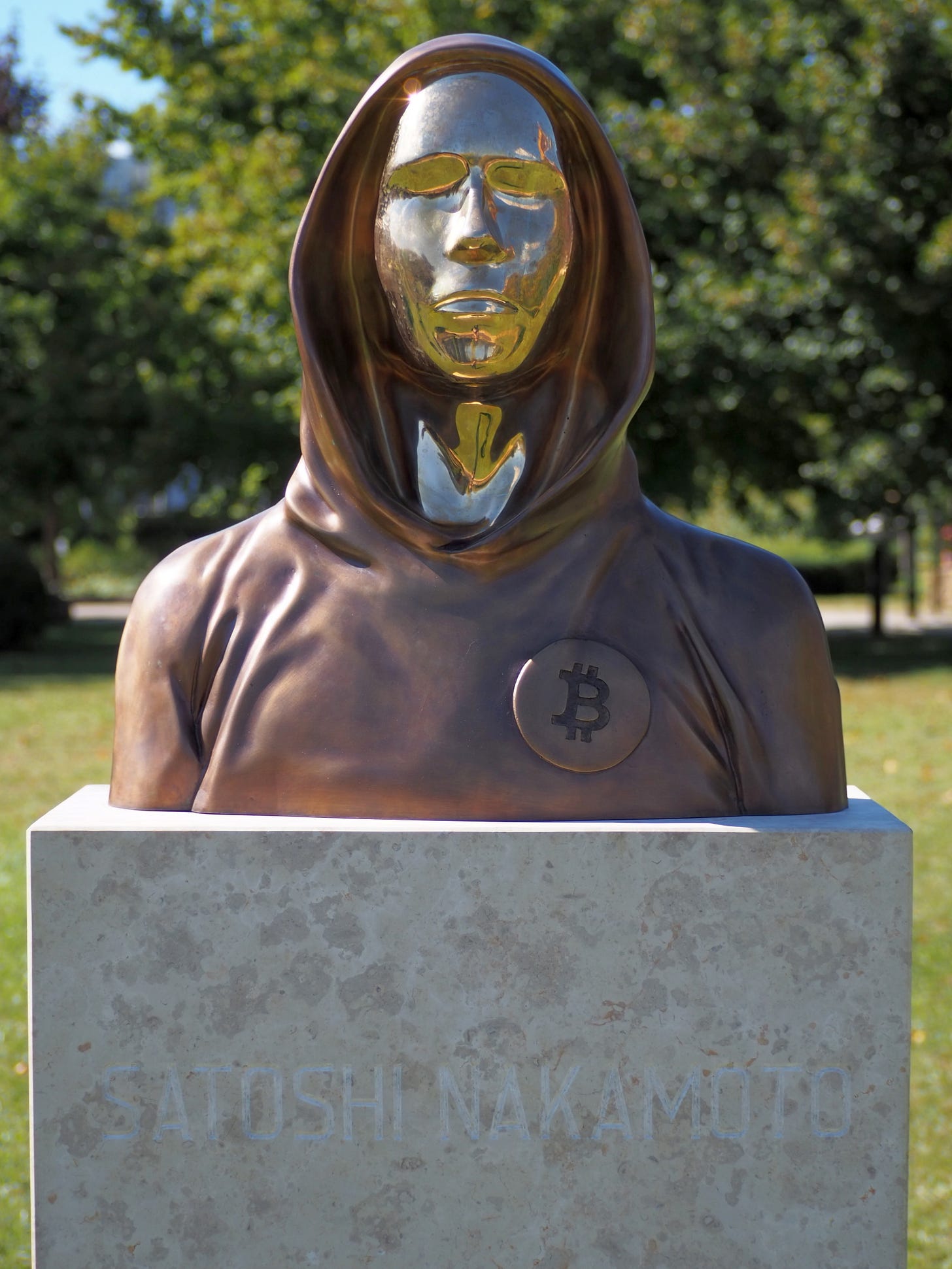Is it truly the currency of the future? . . .
“Bitcoin is life.
Bitcoin is hope.
Bitcoin is money for a better world.
It’s money for the people.
Bitcoin is freedom money.”
- Matthew Kratter, Bitcoin Influencer & Investor
By Scipio Eruditus - February 16, 2025
In an era defined by rapid technological transformation and an ever-encroaching surveillance state, Bitcoin has been lauded as the panacea for our (admittedly) antiquated, debt-based, fiat monetary system. However, a growing body of evidence and analysis suggests that beneath the veneer of libertarian utopianism, Bitcoin serves a very different purpose.
At its inception in 2008, Bitcoin was conceived of as a “peer-to-peer electronic cash system” — a radical departure from the centralized paradigms that had defined monetary policy for the previous two centuries. The genius of Bitcoin lies in its novel amalgamation of cryptographic hashing and digital signatures. Hash functions, by design, transmute any input data into a fixed-length, ostensibly unique string: a digital fingerprint that is near-impossible to replicate. As such, digital signatures furnish a mechanism for the verification of transactional authenticity. The integrity of Bitcoin’s blockchain — the indelible, distributed ledger that records every transaction — is inextricably bound to the hash function known as SHA-256.
Herein lies an early portent of the platform’s double-edged nature: SHA-256 was a creation of the National Security Agency (NSA):
The integrity of Bitcoin’s blockchain and consensus over the ordering of transactions depend on a hash function called SHA-256, which was designed by the NSA and published by the National Institute for Standards and Technology (NIST).
Cryptography researcher Matthew D. Green of Johns Hopkins University said, “If you assume that the NSA did something to SHA-256, which no outside researcher has detected, what you get is the ability, with credible and detectable action, they would be able to forge transactions. The really scary thing is somebody finds a way to find collisions in SHA-256 really fast without brute-forcing it or using lots of hardware and then they take control of the network.” - What Do the Latest NSA Leaks Mean for Bitcoin?
Thus, while the ostensible brilliance of Bitcoin’s decentralized ledger seduces libertarians and technophiles alike, its reliance on an NSA-engineered technology — at the very least — opens up the possibility of a purposely engineered backdoor in its core cryptographic functions. Truly, it strains credulity to believe that the masters of digital lockpicking would release a lock to the world they don’t have the key to. Regardless of Bitcoin’s origins or its tangential ties to the NSA, the transparency of Bitcoin’s blockchain ledger serves as a veritable panopticon.
Every transaction forms a detailed tapestry of economic activity, readily exploitable by those possessing the requisite analytic and technical resources — like say, state security and intelligence agencies.

Bust in honor of “Satoshi Nakamoto” in Budapest, Hungary
Moreover, the still elusive figure of Bitcoin’s inventor, Satoshi Nakamoto, intensifies the currents of suspicion. There is little controversy over the interpretation of Satoshi as meaning “intelligence.” However, his surname, Nakamoto, is more opaque; some have suggested it may mean “central origin.” Though a definitive interpretation is hampered by the absence of the kanji, this alternative reading intimates that Bitcoin’s genesis might be less a spontaneous act of anarchistic rebellion than a calculated maneuver to lay the intellectual groundwork for an all-encompassing system of control.
It is also incumbent upon us to distinguish Bitcoin from the broader phenomenon of blockchain technology. Whereas Bitcoin represents one specific instantiation of this technology — digital currency — blockchain itself is applicable to a myriad of domains, including logistics, identity verification, and “smart contracts.” The gradual normalization of blockchain constitutes a subtle indoctrination into a not-so distant future where every transaction, every datum, is permanently recorded and accessible. In this light, Bitcoin is not an isolated experiment but rather the herald of an all-encompassing digital order wherein surveillance is embedded in the very infrastructure of our economic and social lives.
Thus, what at first blush appears to be a revolutionary system of decentralized finance presages a future in which the state wields unprecedented power over the minutiae of individual economic conduct.
“Blockchain technology is a powerful but underutilized forensic tool for governments to identify illicit activity and bring criminals to justice.” - Michael Morell, Acting CIA Director. An Analysis of Bitcoin’s Use in Illicit Finance, April 6th, 2021
The mythos of Bitcoin as an impervious, tamper-proof sanctuary of financial autonomy is a narrative ardently propagated by its supporters. Yet, a more circumspect analysis reveals that the very features extolled as enablers of freedom may also constitute its Achilles’ heel. Beneath the veneer of anonymity lies a system of considerable vulnerability — one whose cryptographic fortifications are not immune to exploitation, and whose ostensibly immutable ledger is a veritable treasure trove for state actors.
The history of Bitcoin makes it clear that its technical underpinnings are not static; they are steered by a cadre of “core developers”:
[We] typically hear that “crypto is different” because it’s decentralized, but in fact, it’s not decentralized. At every level, there are people controlling things.
We heard that Bitcoin is decentralized. Well, Bitcoin is controlled by a few core software developers—fewer than ten—and they can make changes to the software, and then that software is implemented by mining pools, and there are just a few of them. So in all of these spaces, there are definitely people—often very few people—pulling the strings. - Professor Hilary Allen, December 14th, 2022
Although the decentralized mythos suggests that no single entity may commandeer the network, history reveals that a select group of influential programmers retains the power to effectuate pivotal modifications to the blockchain. While the twenty-one million cap on Bitcoin is oft lauded as a hedge on potential inflationary pressures, it remains theoretically possible to increase that limit — a proposition that has increasingly been discussed in recent years. This malleability, while a testament to the system’s adaptability, also renders it amenable to future subversion, like in the case of a 51% attack.
The transparent nature of blockchain technology reveals itself as a potent forensic instrument in the hands of government agencies. With sophisticated analytical algorithms at their disposal (courtesy of our tax dollars), intelligence agencies have already dissected the public ledger, correlating disparate transactions to construct detailed profiles of individual behavior. As Roger Ver astutely noted (emphasis mine):
Confiscation has already become easy due to the trend towards custodial wallets. It happens all the time. Because the blockchain is public, governments can mark particular coins as suspicious and track them throughout the ledger. If the coins arrive at a centralized cryptocurrency exchange, as they usually do, the exchanges will freeze the corresponding accounts and notify the authorities. The coins in question can then be seized with a few clicks. Even if the coins do not move to a centralized exchange, they have likely moved from one, which—due to compliance with know-your-customer (KYC) laws give the government the identity of at least one person who has touched those coins. From that point, they can surveil the blockchain to track the economic activity of that individual and work out plausible identities for anybody they have transacted with. This already happens when Bitcoin is involved with large criminal cases, but there is no fundamental reason why it couldn’t happen to everyday users. - Hijacking Bitcoin: The Hidden History of BTC
This capacity for rapid, algorithm-driven confiscation is not merely a hypothetical menace — it is a present and palpable reality. One need look no further than the outbreak of the Ukraine War: Bitcoin was immediately . . .
[SNIP]







































